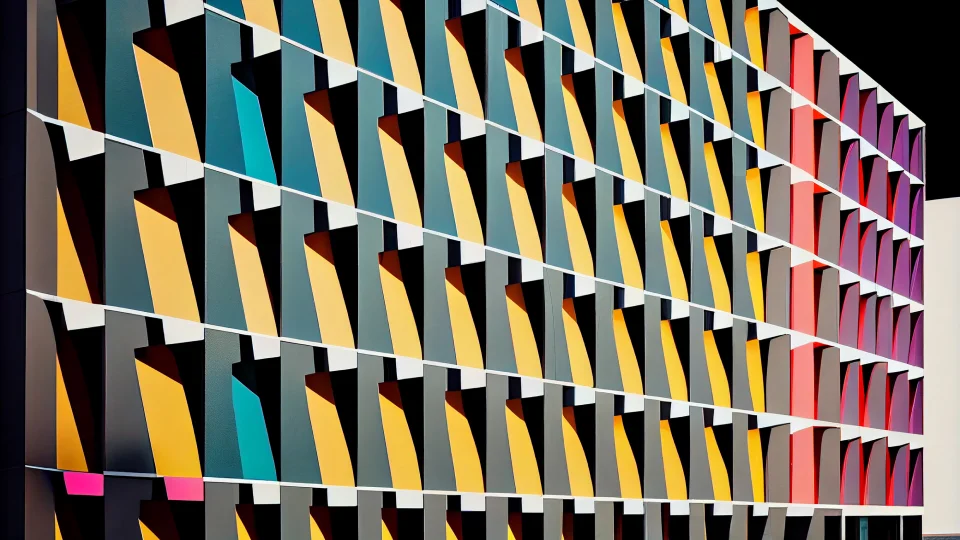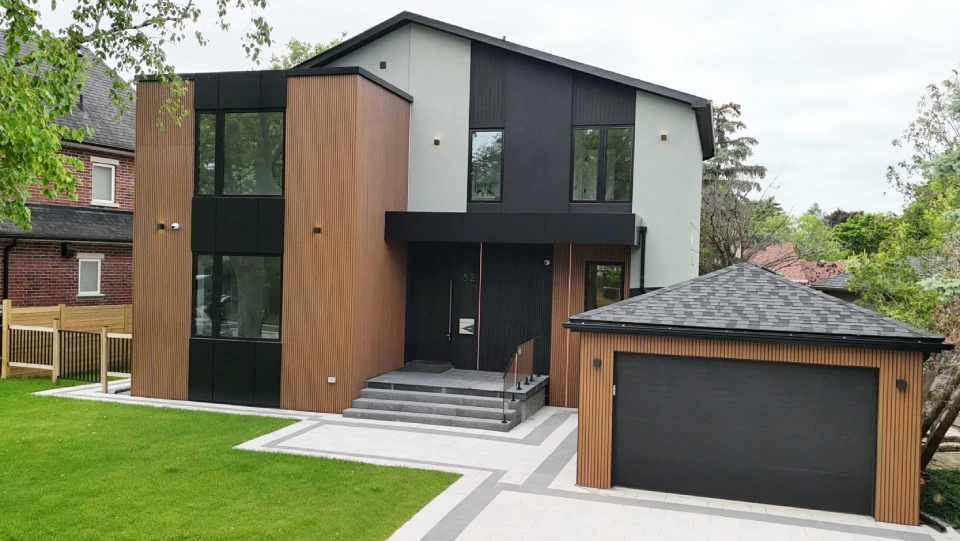Exterior cladding trends in Canada have evolved dramatically as designers and homeowners increasingly prioritize aesthetics, durability, and sustainability. Exterior cladding serves as a critical layer in construction, offering protection against the harsh Canadian climate while enhancing visual appeal. Today’s top cladding trends in Canada reflect a blend of innovation and environmental awareness, with materials engineered for resilience and reduced environmental impact. This article highlights the leading cladding trends in Canada.
What Is Exterior Cladding?
Exterior cladding is the protective outer layer applied to buildings to guard against elements such as wind, moisture, and temperature changes. Cladding can vary in material, from traditional options like brick and stone to modern choices like ACM or Fiber Cement. This material diversity allows homeowners and architects to choose styles that align with both functional and aesthetic preferences.

Why Are Exterior Cladding Trends Important?
Exterior cladding trends matter because they reflect broader shifts in architectural preferences, technology, and environmental priorities. Trends in cladding materials play a vital role in building durability, energy efficiency, and the reduction of long-term maintenance. As sustainability becomes a priority, many Canadian homeowners look to cladding trends that promote greener practices.
Most popular cladding trends (In Canada)
The most popular cladding trends in Canada today lean towards modern, durable, and safe materials, moving away from traditional, classic exteriors. These options not only have visual appeal but also enhanced functionality, including weather resistance, fire safety, and energy efficiency.
In this section, we outline and explain the most common and popular cladding options.
1. Aluminium Composite Material (ACM)
Aluminium Composite Material (ACM) is at the forefront of cladding innovations in Canada. ACM consists of two thin aluminum sheets bonded to a non-aluminum core, offering a lightweight, durable, and fire-resistant option for building exteriors.
Wallcent’s engineered ACM panels are crafted to meet the highest safety standards, offering Canadian homeowners and businesses a cladding solution that’s as reliable as it is stylish. Built for both durability and peace of mind, Wallcent’s ACM provides a modern, fire-resistant finish that enhances the look of any property while standing up to Canada’s toughest weather conditions. Choose Wallcent ACM for a bold, beautiful exterior that protects what matters most.
- Benefits of ACM
One of the main appeals of ACM lies in its versatility. It is available in numerous colors, finishes, and textures, allowing homeowners to customize their building exteriors. ACM is highly resistant to fading, corrosion, and fire, essential for long-term performance. Additionally, it is lightweight, reducing structural load while providing a modern, polished look.
2. Wood Plastic Composite (WPC)
Wood-Plastic Composite (WPC) is a rising star in the cladding market. Combining the aesthetics of wood with the durability of plastic, WPC offers the best of both worlds. Unlike traditional wood, WPC is resistant to moisture, rot, and insects, making it an ideal choice for Canada’s variable climate.
- WPC Is Ideal for Canadian Climates?
WPC’s resistance to moisture makes it perfect for regions with high humidity or heavy snowfall. It can endure both frigid winters and hot summers, maintaining its appearance and structural integrity with minimal upkeep.
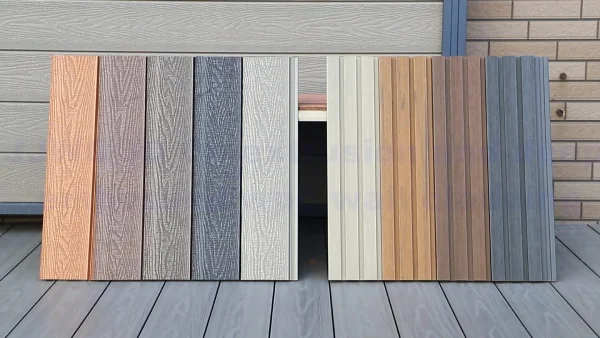
3. Fibre Cement Cladding
Fiber cement is an engineered cladding material composed of cement, sand, and cellulose fibers. Known for its resilience and natural appearance, fiber cement mimics the look of wood or masonry without the maintenance demands. This cladding type is especially popular in Canada due to its ability to withstand severe weather conditions.
- Environmental Benefits of Fiber Cement
Fiber cement is an eco-friendly choice because it’s composed of recyclable materials and has a long lifespan. The material’s resistance to decay reduces the need for frequent replacements, lowering the building’s overall environmental impact.

4. Metal Cladding
Metal cladding, particularly with materials like aluminium and steel, has become a staple in modern Canadian architecture. Its sleek appearance and unmatched durability make it a go-to choice for both residential and commercial projects. Metal cladding is highly resistant to rust, fire, and impacts, making it a practical choice for areas prone to extreme weather.
Types of Metal Cladding
- Standing Seam Panels: Known for their durability and watertight construction, these panels are ideal for harsh climates.
- Corrugated Metal Panels: Lightweight and economical, these are popular in both urban and rural settings.
5. Natural Stone Veneers
For those seeking luxury and elegance, natural stone veneers are a timeless option. Stone veneers are thin layers of natural stone applied to the exterior of buildings, offering an authentic look without the structural weight of full stone blocks.
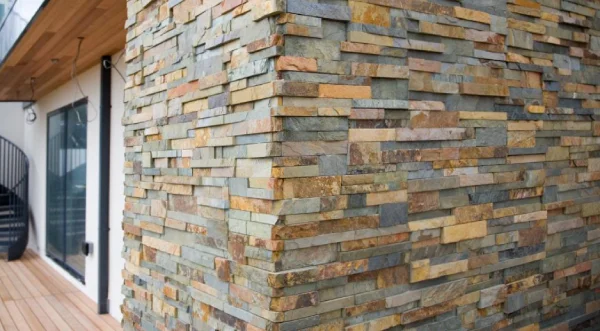
6. Brick and Masonry Cladding
Brick and masonry cladding represent durability and classic appeal. These materials provide excellent thermal mass, helping to regulate indoor temperatures. With minimal upkeep, brick and masonry can last for decades, making them a sound investment.
7. Vinyl and PVC Cladding
Vinyl and PVC cladding are popular choices due to their affordability, lightweight nature, and versatility. Available in numerous colors and styles, vinyl cladding can mimic wood and other materials. Its UV resistance also makes it an ideal choice for areas with significant sun exposure.
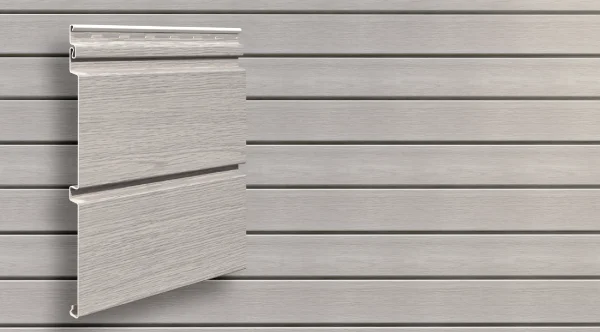
Color and Texture Trends in Exterior Cladding
As cladding materials advance in durability and eco-friendliness, color and texture trends are also evolving to reflect contemporary architectural styles and Canadian landscape inspirations. Here’s a closer look at the latest color and texture preferences:
1. Neutral and Earthy Tones
Include: Soft grays, warm taupes, and rich browns are highly sought after. These shades create a grounded, natural look that integrates well with Canada’s diverse landscapes.
Neutral tones are timeless, versatile, and match a variety of architectural styles from modern to traditional.
Fiber cement, ACM, and natural stone often showcase these hues, making them a perfect fit for homeowners seeking longevity and low-maintenance elegance.
2. Dark and Bold Statement Colors
Charcoal gray, navy blue, deep green, and even matte black are increasingly popular, giving a sophisticated, dramatic look.
These colors make a bold statement, creating a high-contrast effect that stands out against natural surroundings, especially in winter settings.
Metal cladding and wood composites take on dark shades well, as these materials can achieve deep pigmentation and have excellent UV resistance, maintaining their richness over time.
3. Textured Finishes and Natural-Look Materials
Many homeowners prefer textured finishes that mimic natural materials like wood grain or stone, which adds warmth and character.
Textures provide depth and visual interest, especially in minimalist or modern architectural designs. They also help cladding blend with natural environments.
WPC, fiber cement and ACM can be manufactured to resemble wood and stone textures, combining low-maintenance qualities with a realistic look.
4. Matte and Low-Gloss Finishes
Matte or low-sheen finishes are in demand for a refined and subdued aesthetic.
Matte finishes reduce glare and give buildings a softer, more sophisticated appearance, which is particularly attractive in urban or residential settings.
ACM and vinyl cladding often feature matte finishes that reduce reflections and integrate seamlessly into both modern and rustic designs.
5. Multitone and Blended Color Variations
Using multitone or gradient cladding panels to create subtle color variation across a building’s exterior.
Multitone options give a dynamic, lively appearance that adds visual interest without overwhelming the design.
Fiber cement and natural stone veneers often display multitone effects, where each panel has slight color differences, offering an organic, less uniform look.
Incorporating these color and texture trends helps homeowners create exteriors that not only look visually stunning but also harmonize with Canada’s varied seasonal landscapes. By choosing a trending colour or finish, they can ensure their homes remain stylish, sustainable, and reflective of contemporary design principles.
Why Is Modern Cladding So Popular?
Modern cladding materials have surged in popularity due to their impressive blend of aesthetics, performance, and sustainability. As architectural trends evolve, homeowners and builders are increasingly drawn to cladding options that offer a sleek, contemporary look while meeting the practical demands of Canadian climates.
Benefits such as durability, excellent resistance to harsh weather, eco-friendliness, a variety of designs and colours and minimal maintenance costs makes modern cladding a top choice for commercial and residential buildings in Canada.
Conclusion
In summary, Canada’s exterior cladding trends reflect a balance between modern aesthetics and environmental responsibility. From the versatile Aluminium Composite Material (ACM) to sustainable options like fiber cement and Wood-Plastic Composite (WPC), the cladding market offers diverse choices that cater to the unique Canadian climate. Whether you’re drawn to the sleek lines of metal cladding or the classic look of brick and stone, each material presents options that combine resilience and beauty
